How to Increase Spend Under Management In 6 Steps


Spend under management (SUM) refers to the amount of money spent by a business that’s overseen and managed by the procurement function.
When you work towards bringing more spend under control, you essentially create more opportunities for cost savings and help prevent risks such as fraud or maverick spend.
However, increasing SUM can be quite tricky if you don’t have the right processes in place.
This is exactly where this article comes in.
In this blog post, you’ll find six key steps for unlocking better spend management practices and getting your overall spend right where it needs to be: under your control.
Let’s get right into it.
First, take a hard look at how you currently manage spend. Analyze the organization’s spending patterns and evaluate your overall procurement processes.
This will help you pinpoint areas of unmanaged spend and understand what exactly needs to be fixed in order to bring more of it under control.
According to a 2024 Payhawk survey, organizations today struggle with all sorts of inefficiencies in their spend management practices, from human error and wasted time on reconciliation to inadequate software and processes.
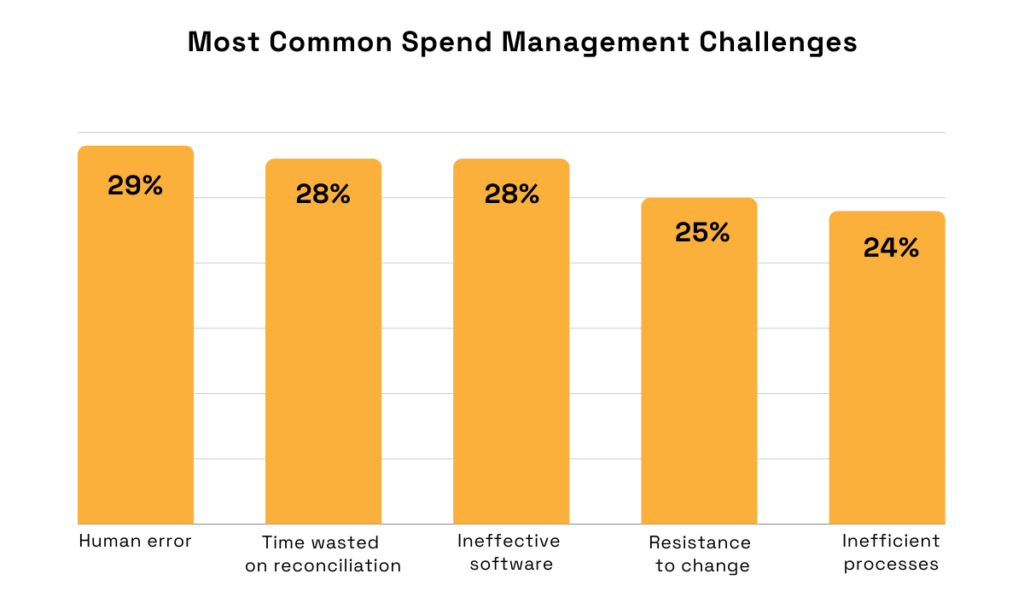
Illustration: Veridion / Data: Payhawk
Maybe this is the case with your business, too.
Maybe your approval procedures are too complex or slow, leading employees to cut corners and operate outside your formal procurement policies.
Or, maybe your systems for tracking spending are disconnected and ineffective, resulting in poor spend visibility and significant oversights.
One thing is certain: when purchasing and spend management practices falter, opportunities for out-of-process buying and inefficient spending multiply.
The result?
You miss out on cost savings opportunities and hurt your bottom line.
For instance, did you know that EY research showed that effective category management and strategic sourcing can reduce organizational spending by 10-15%?
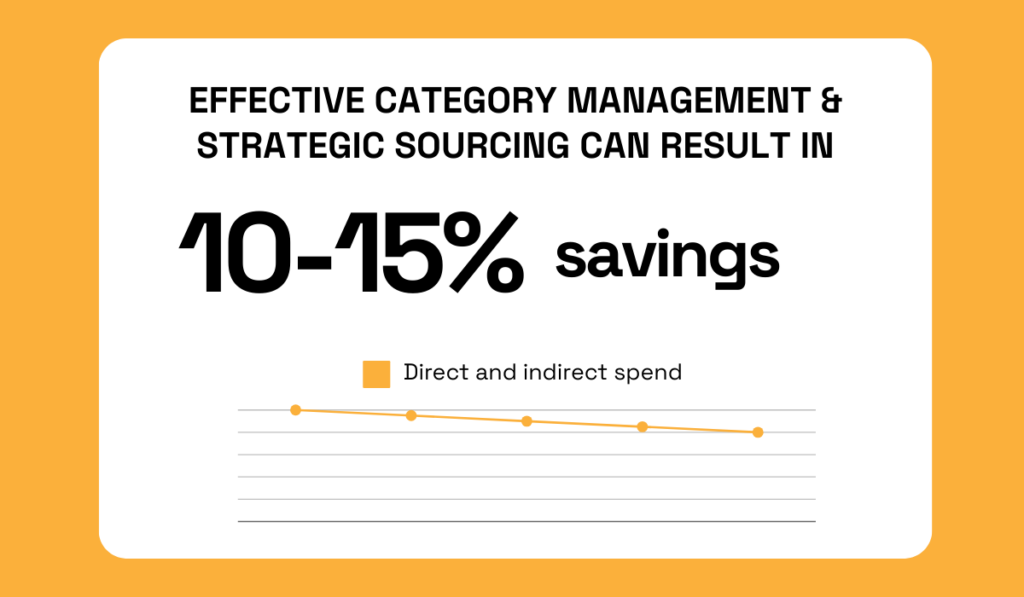
Illustration: Veridion / Data: EY
This is because when your spend is overseen and managed by procurement, you can more effectively control costs through strategies like volume pricing or exclusive supplier deals.
So, start assessing your processes as soon as possible.
Based on your findings, you’ll be able to set well-informed goals as well as appropriate tactics to increase your SUM and take the company’s financial performance to the next level.
To increase spend under management, you need reliable spend data, no two ways about that.
Understanding how much is spent and on what enables you to create more accurate spend profiles and, in turn, identify and address (un)managed spending.
Nicolas Olague, General Manager at Amazon Business, explains that not many companies actually prioritize spend visibility, and, consequently, have no way of controlling where their money goes.
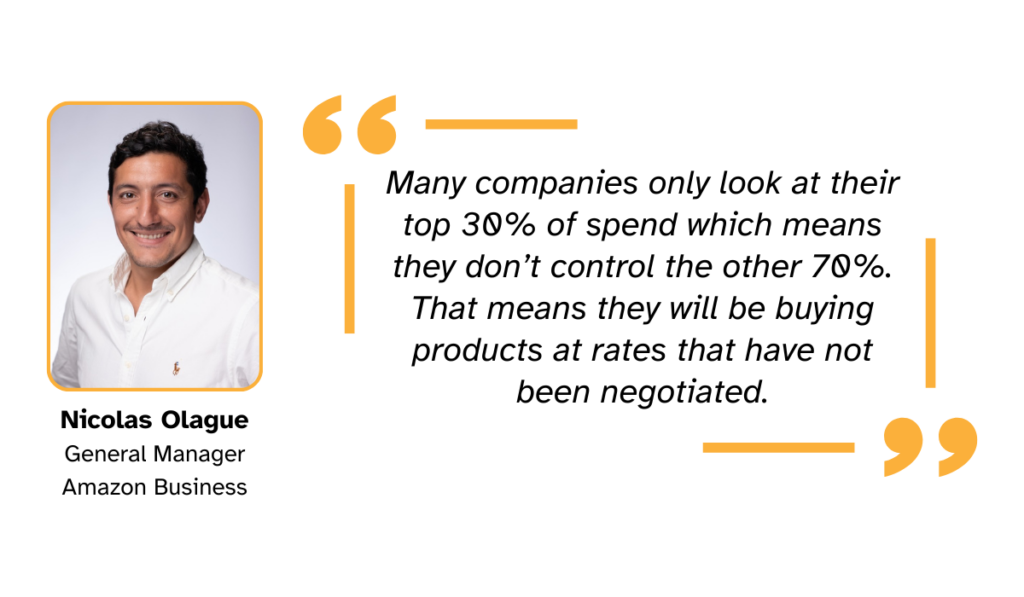
Illustration: Veridion / Quote: Independent
In contrast, when you do have insights into, say, how much you spend with each supplier, you can start putting more effective cost-saving policies in place, Olague elaborates.
These policies could mean setting spend limits for each vendor or consolidating suppliers to unlock discounts.
So, how exactly can you achieve this data transparency?
The most important thing to do is to establish a dependable, single source of truth.
Why?
Because if all that vital information is scattered across multiple incompatible systems, you’ll have trouble verifying and making sense of it.
In fact, a survey by SpendHQ found that data silos and separate data sources are the main obstacles to spend visibility.
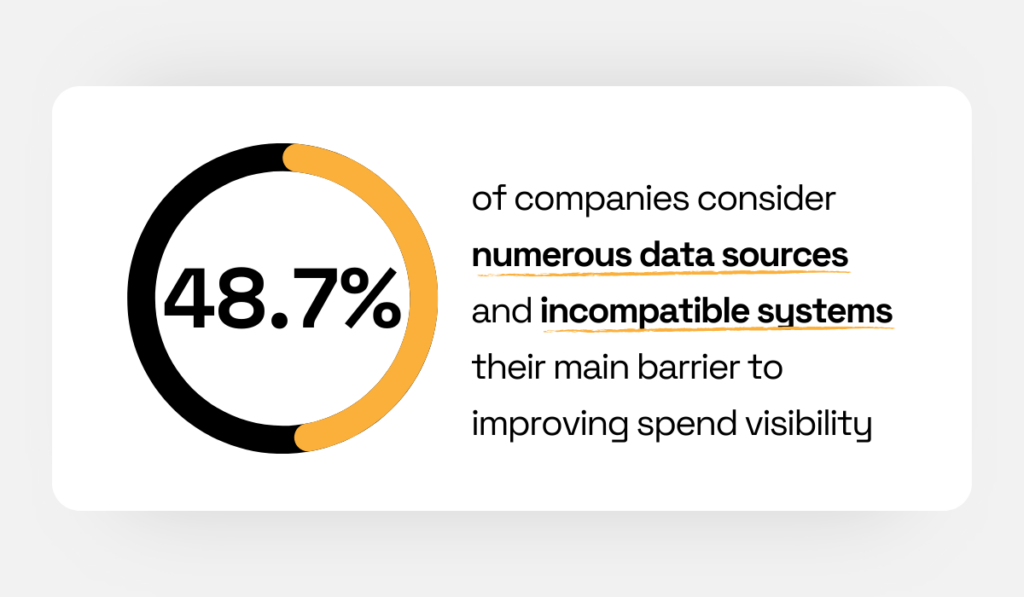
Illustration: Veridion / Data: SpendHQ
So, consider implementing solutions like ERP systems or dedicated spend management platforms to centralize all your procurement and financial data.
This is precisely what one global logistics firm did.
Thanks to their spend optimization platform, they were able to raise their spend visibility by a staggering 95%.
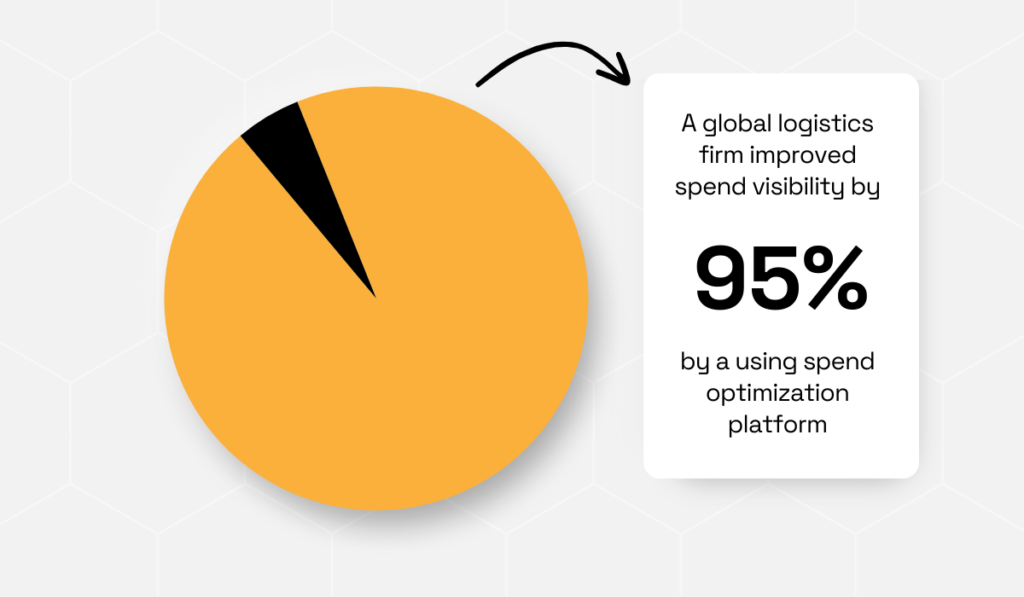
Illustration: Veridion / Data: Accenture
Before putting the solution into action, their data was siloed and decision-makers had no access to timely, accurate information.
However, the system was able to consolidate and cleanse their data across all their facilities and offices in more than 80 countries, transforming their spend visibility beyond recognition.
The bottom line?
You can’t control what you can’t properly see.
This is why boosting your spend visibility is of paramount importance. It directly translates to faster detection of areas for improvement and more strategic, well-formed decisions.
Establishing a procurement policy involves creating a clear set of procedures and standards to ensure the efficient and cost-effective acquisition of goods and services for the company.
By doing so, you formalize the purchasing process, which in turn leads to better-managed and predictable spending.
Co-founder and CEO of a procurement startup ORO Labs, Sudhir Bhojwani, agrees.
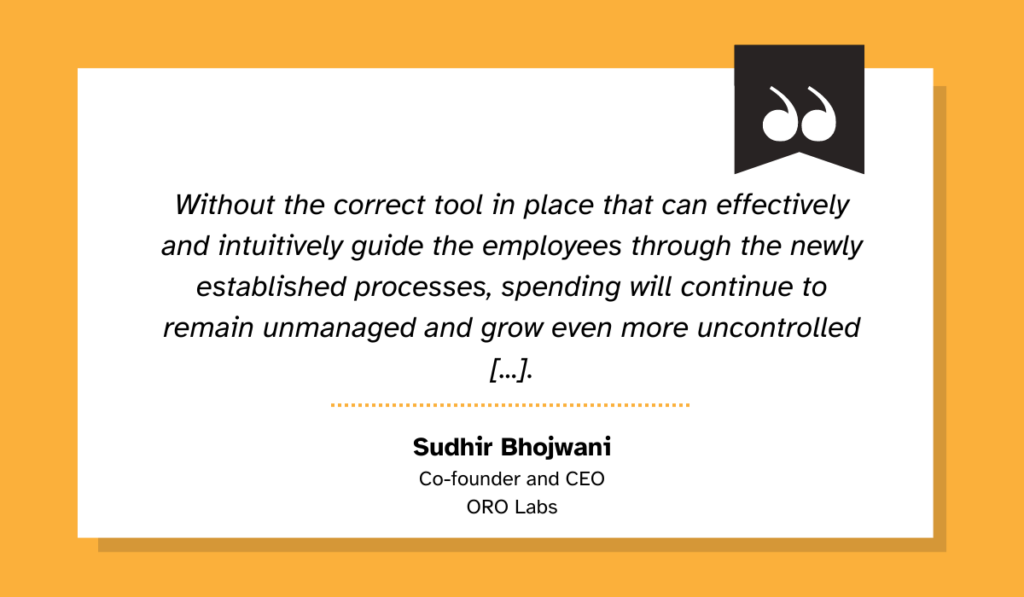
Illustration: Veridion / Quote: Procurement Magazine
Essentially, he points out that without the right tool to guide your employees through the procurement cycle, spend can easily spiral out of control.
Well, your procurement policy is that tool.
It outlines standard procedures, approved vendors, purchasing limits, and more, ensuring consistency and accountability among staff.
Without such guidelines, confusion would surely ensue, and so would the unmanaged spending.
So, which specific elements should you include in your own policy?
While that in part depends on your unique needs and circumstances, there are some sections that are commonly incorporated:
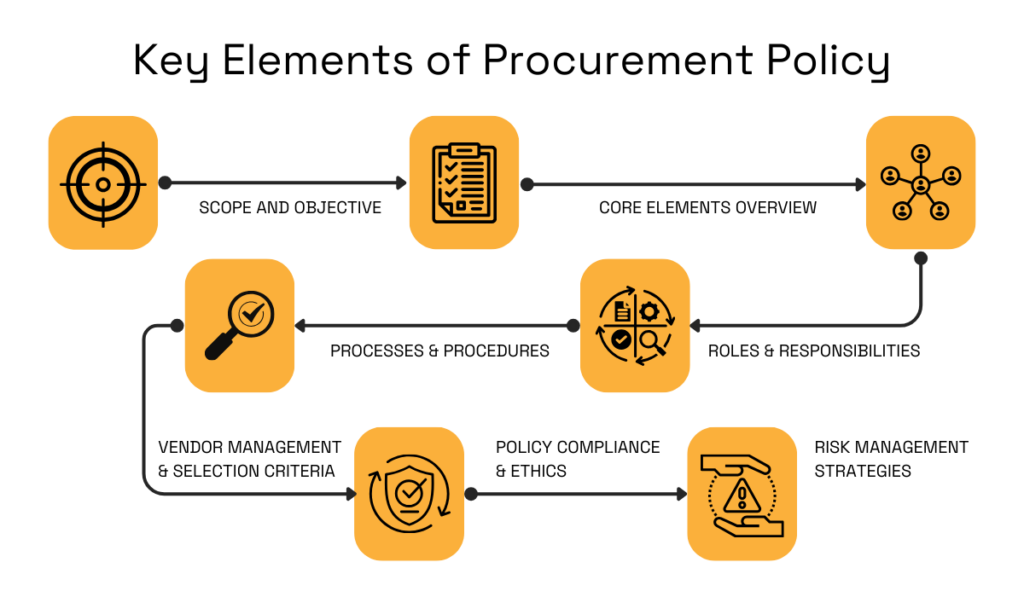
Source: Veridion
Of course, you can customize each section, add new ones, or remove those that aren’t relevant to you.
However, be sure to consult with all the stakeholders before finalizing the document. This includes everyone affected by it, like your team or suppliers.
Michele Romano, Senior Professional in IT Tender & RFx Management at an energy company Eni, is all about this approach.
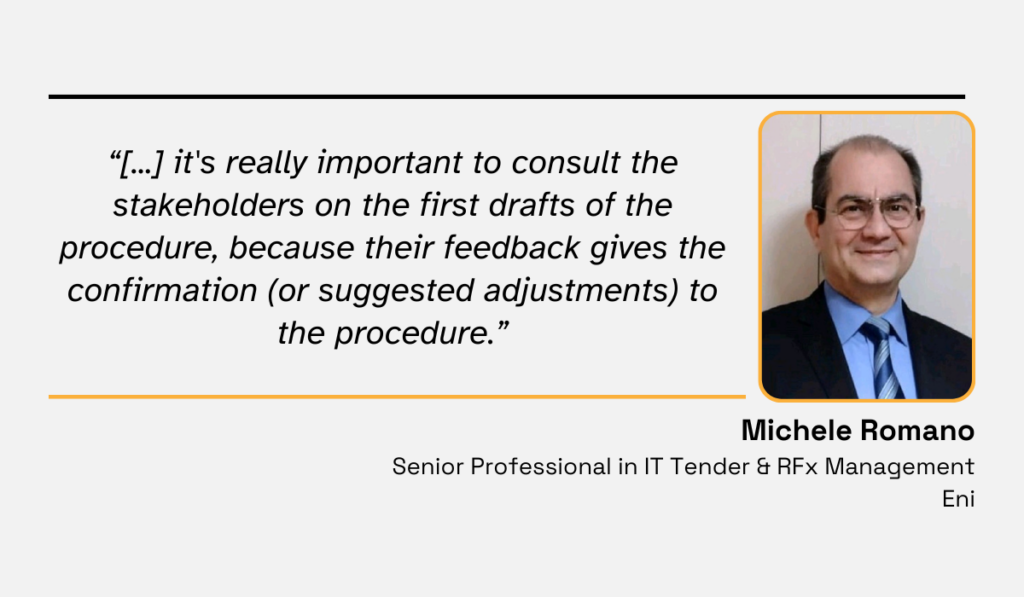
Illustration: Veridion / Quote: LinkedIn
It gives the stakeholders the opportunity to voice their opinions, share concerns, and even offer advice on how to improve the policy.
At the same time, it allows you as the policy-maker to explain its purpose, benefits, and expectations in more detail.
That way, you make sure the guidelines are realistic and easy to follow.
After all, what good is a procurement policy if no one adheres to it?
Effective supplier management can significantly boost your organization’s spend under management.
So, take a moment to reflect: How frequently do you take the time to evaluate your suppliers’ performance?
And how easy is it to manage your vendors anyway?
Remember: if your suppliers and staff find your current management system confusing or cumbersome, they’re more likely to bypass it, or at least not use it properly, which can lead to more unmanaged spend.
Supplier contract management is a perfect example.
Poor contract control can cause leakage, where the actual value you’re getting from a contract does not measure up to the value you expected.
Contract leakage can manifest as, for instance, missed opportunities for discounts, increased operational costs, and agreeing to unfavorable terms and conditions.
Obviously, this can have a serious impact on your financial performance.
In fact, World Commerce and Contracting has already calculated that ineffective contract management can cost companies about 9% of their bottom line.
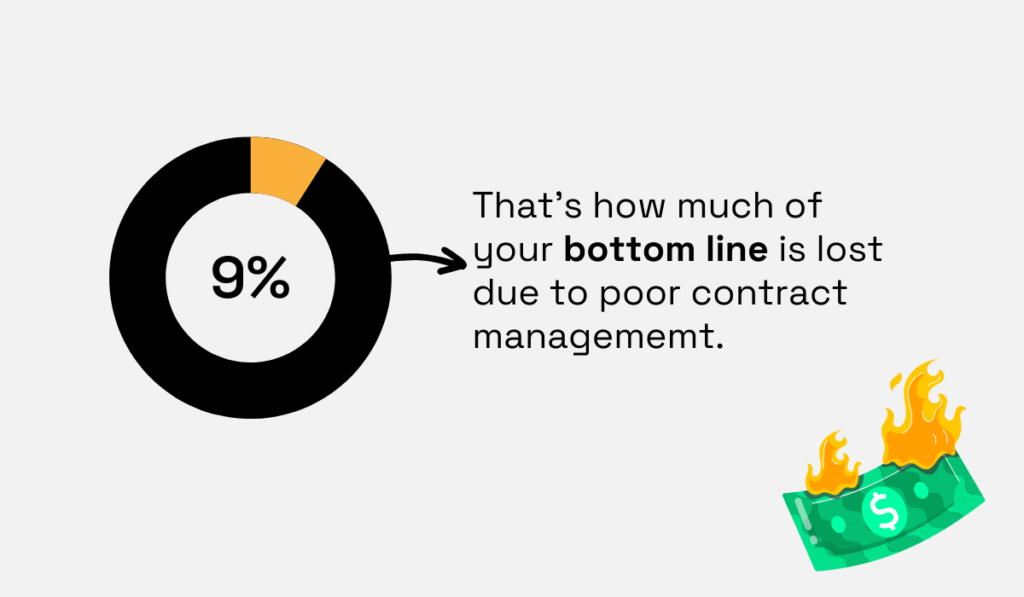
Illustration: Veridion / Data: World Commerce & Contracting
That’s certainly not something to glance over.
So, to avoid this issue, be sure to always clearly define contractual conditions, approve any pricing adjustments on time, and closely monitor your suppliers’ performance against the agreed-upon terms.
Another problem stemming from poor supplier control is fraud.
Without proper vendor verification processes or accurate supplier information, fraudulent suppliers can be added to your vendor lists and receive payments without ever delivering the goods that were promised to you.
Costas Xyloyiannis, CEO of HICX, the supplier experience management platform, elaborates on how this problem happens.
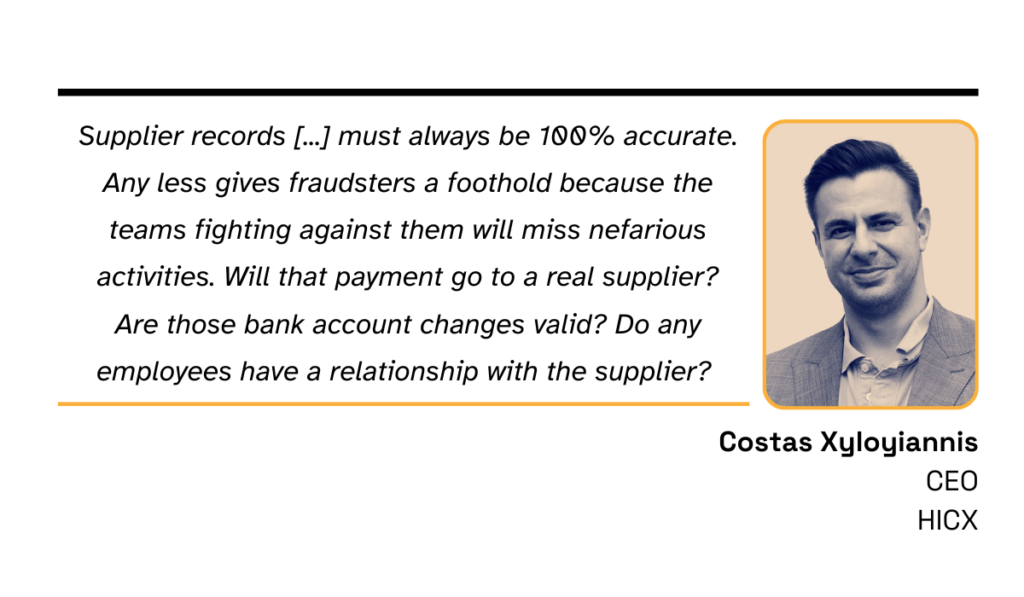
Illustration: Veridion / Quote: Supply Chain Digital
When fraud happens, it not only diverts funds meant for legitimate suppliers but also distorts your financial data, making it difficult to understand your actual spend profile.
Luckily, such issues can be fixed by establishing a thorough onboarding and risk assessment process.
For example, you could use a security questionnaire to establish a risk profile for each new vendor you start working with.
This allows you to learn more about your vendors and helps ensure that you collaborate only with the most dependable partners from the get-go.
Overall, investing in efficient supplier management is an absolute must for maintaining and increasing control over your spend.
By doing so, you mitigate risks and operational inefficiencies as well as ensure that all purchases are made only with approved and reliable suppliers.
Bringing spend under control is definitely no easy feat, and each step we’ve covered so far can be quite labor-intensive in itself.
Luckily, technology can make a world of difference in this context, infusing every task and process with more speed, accuracy, efficiency, and transparency.
For example:
Put simply, when automation is part of your strategy, all vital, yet time-consuming processes become much more streamlined.
You come to the point where cutting corners and operating outside official procurement channels becomes unthinkable.
As a result, the chances of increasing your SUM grow considerably.
Just take Jabil as an example. They are an American multinational manufacturing company specializing in electronic circuit board assemblies and systems.
They were able to bring an unbelievable $2 billion under control thanks to their spend management system.
Heidi Banks, their Vice President of Global Supply Chain, elaborates on how exactly they use the solution:
“We can see if there are different behaviors we need to look into. Maybe there are suppliers that are bidding at the last minute and winning, or less than a desirable number of suppliers coming in, or duplicate invoices. [We’re also able to] see spend patterns that we would otherwise never uncover.”
Ultimately, their investment paid off significantly, delivering a 3x ROI by the end of the second year two and a 7x ROI by the fourth.
Of course, you don’t have to be a manufacturing giant to achieve such results.
Any company can benefit from a software tool that automatically identifies spending patterns and opportunities for cost savings as well as streamlines the procurement process from requisition to payment.
However, be sure to consult with the stakeholders from all departments within the organization in order to ensure successful implementation, just like they did at Jabil.
As Banks explains, this was the key move for them, helping avoid any pushback from various departments:
“We bought in IT, legal, procurement and, in advance did a balanced scorecard approach to say these are the important factors […] to make sure that when we came out of that decision, and we picked a solution, we could all […] say it was the right decision for us as a company.”
And once you secure collective buy-in and everyone gets used to the new system, you’ll realize something remarkable: managing spend doesn’t have to be a hassle at all.
All you needed was the right digital solution all along.
To keep your spend under management on an upward trajectory, you need to constantly reevaluate and measure the effectiveness of your spend control strategies and practices.
By doing so, you can gain more insights into your overall performance and even uncover areas for improvement.
For instance, you might notice that all of a sudden, you started overspending in particular areas, or that certain suppliers don’t deliver the level of quality they used to.
These are all issues that can be fixed, but only if you detect them on time.
And that’s where performance measurement comes into play.
Jeetendra Kasar, Business Head for Pricol Limited, an Indian automotive technology and precision-engineered solutions company, perfectly summarizes what this step is all about.
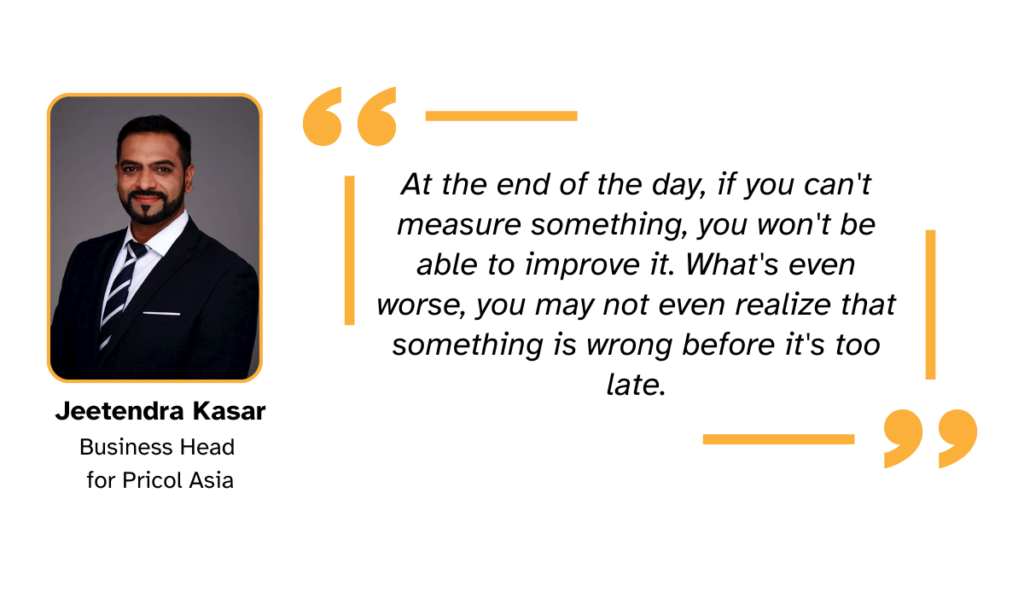
Illustration: Veridion / Quote: LinkedIn
So, to track your performance effectively and catch problems on time, consider establishing clear KPIs.
These quantifiable metrics will help you stay objective during your assessment and keep you focused on aspects of your operations that truly matter.
Some examples of relevant KPIs in this context are:
By keeping an eye on these metrics, you’ll be able to quickly spot when something is off track.
And then, you can focus on finding the root cause, develop an action plan to fix the problem, and maximize your SUM.
All in all, increasing spend under management boils down to three key elements: establishing effective procurement processes, ensuring everyone adheres to them, and constantly measuring their impact.
With clear, easy-to-follow procedures in place, you don’t have to worry about staff deviating from protocols, suppliers failing to deliver on agreed-upon terms, or fraud, whether internal or external.
Instead, you can focus on making the most out of your financial resources and securing the best possible deals.
But it isn’t just about that.
With SUM maximized, you transform the procurement function into a valuable strategic partner that fuels the company’s growth and helps it stay ahead of the competition.